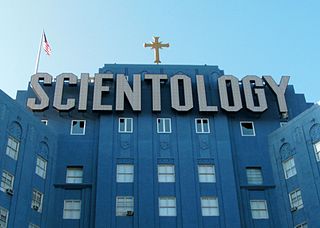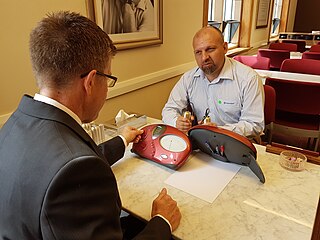Related Research Articles

Dianetics is a set of ideas and practices, invented in 1950 by science fiction writer L. Ron Hubbard, regarding the human mind. Dianetics was originally conceived as a form of psychological treatment, but was rejected by the psychological and medical establishments as pseudoscientific. It was the precursor to Scientology and has since been incorporated into it. It involves a process referred to as "auditing", which utilizes an electrical resistance meter, ostensibly to remove emotional burdens and "cure" people from their troubles.

Free Zone, Freezone, and Independent Scientology are umbrella terms for the groups, organizations, and individuals who practice Scientology beliefs and practices independently of the Church of Scientology (COS). Such practitioners range from those who closely adhere to the original teachings of Scientology's founder L. Ron Hubbard, to those who have adapted practices far from COS beliefs and practices.

Followers of the Scientology movement maintain a wide variety of beliefs and practices. The core belief holds that a human is an immortal, spiritual being (thetan) that is resident in a physical body. The thetan has had innumerable past lives, some of which, preceding the thetan's arrival on Earth, were lived in extraterrestrial cultures. Based on case studies at advanced levels, it is predicted that any Scientologist undergoing auditing will eventually come across and recount a common series of past-life events.

The E-Meter is an electronic device used in Scientology that allegedly "registers emotional reactions". After claims by L. Ron Hubbard that the procedures of auditing, which used the E-Meter, could help heal diseases, the E-Meter became the subject of litigation. Since then, the Church of Scientology publishes disclaimers declaring that the E-Meter "by itself does nothing", is incapable of improving health, and is used solely for spiritual purposes.

Auditing, also known as processing, is the core practice of Scientology. Scientologists believe that the role of auditing is to improve a person's abilities and to reduce or eliminate their neuroses. The Scientologist is asked questions about past events while holding two metal cylinders attached to an electrical resistance meter (galvanometer) with a dial. The term "auditing" was coined by L. Ron Hubbard in his 1950 book Dianetics: The Modern Science of Mental Health, which describes the process.

Study Technology, also called Study Tech, is a teaching method codified by L. Ron Hubbard, founder of Scientology. Study Technology is used by Scientologists in their training, and it is also marketed outside the Church of Scientology through its affiliated corporation Applied Scholastics, which presents Study Tech as a secular teaching method for any student or topic. However, the method has many critics, including former teachers, claiming that Study Technology and its associated schools are intrinsically linked with religious aspects of Scientology.
Dianetics: The Modern Science of Mental Health, sometimes abbreviated as DMSMH, is a book by L. Ron Hubbard describing a pseudoscientific set of ideas, Dianetics, that would later become part of Scientology. Hubbard claimed to have developed it from a combination of personal experience, basic principles of Eastern philosophy and the work of Sigmund Freud. The book is considered part of Scientology's canon. It is colloquially referred to by Scientologists as Book One. The book launched the movement, which Hubbard later characterised as a religion, in 1950. As of 2013, the Scientology organization's publishing arm, New Era Publications, sells the book in English and in 50 other languages.

Suppressive person, often abbreviated SP, is a term used in Scientology to describe the "antisocial personalities" who, according to Scientology's founder L. Ron Hubbard, make up about 2.5% of the population. A statement on a Church of Scientology website describes this group as including notorious historic figures such as Adolf Hitler.
In Dianetics and Scientology, Clear is a status afforded to followers by the Scientology organization, or by other Scientologists, after they complete certain activities. It is one of the major ostensible "states" practitioners strive to reach on their way up what the Scientologists call the Bridge to Total Freedom. Scientology followers are given the status of Clear when a person is deemed to be free of the influence of engrams – supposed unwanted emotions or painful traumas which Scientology claims are not readily available to the conscious mind. Scientologists believe that human beings accumulate anxieties, psychosomatic illnesses, and aberration due to receiving engrams throughout their current or past lives, and that by applying Dianetics, every single person can obtain the status of Clear.

MEST is an acronym for matter, energy, space and time, and means the physical universe. It was coined in 1950 by Scientology founder L. Ron Hubbard, and is spoken as a word rather than spelling out the letters.
Scientologie, Wissenschaft von der Beschaffenheit und der Tauglichkeit des Wissens is a 1934 book published by Anastasius Nordenholz, in which he defines the term "Scientologie" or "Eidologie" as a science of knowing or knowledge and discusses the philosophical implications of the concept.

Ronald Edward "Ron" DeWolf, also known as "Nibs" Hubbard, was the eldest child of Scientology's founder L. Ron Hubbard by his first wife Margaret Louise Grubb. He is known for having been highly critical of his father and of the Church of Scientology. In his opinion, Scientology was a cult that existed to make money.

An engram, as used in Dianetics and Scientology, is a detailed mental image or memory of a traumatic event from the past that occurred when an individual was partially or fully unconscious. It is considered to be pseudoscientific and is different from the meaning of "engram" in cognitive psychology. According to Dianetics and Scientology, from conception onwards, whenever something painful happens while the "analytic mind" is unconscious, engrams are supposedly being recorded and stored in an area of the mind Scientology calls the "reactive mind".
Practices in Scientology make extensive use of techniques drawn from hypnosis. They are used in 'auditing' and in the Training Routines widely practiced within the Church of Scientology. Hypnosis, in this context, is defined as language and nonverbal communication employed to induce heightened responsiveness and suggestibility. The Church of Scientology denies that its practices involve hypnosis. The organization says that it will not permit individuals who say they have previously experienced hypnosis – as either a subject or practitioner – to participate in Scientology training, with the stated reasoning that there is a possibility of harm caused by the prior exposure to hypnosis.

This bibliography of Scientology includes Scientology and Dianetics-related books, periodicals and other issues authored by L. Ron Hubbard and those produced by the Church of Scientology and its related organizations. Books bearing L. Ron Hubbard's name are considered texts of Scientology's canon.
The amount of material on Dianetics and Scientology is extensive, to say the least. This material is composed of books by L. Ron Hubbard ; compilations of his works; taped lectures; auditor training materials ; course packages; booklets; a large number of magazines and annuals; and video recordings of the major annual events.

The Bridge to Total Freedom, also known as the Classification, Gradation and Awareness Chart, is Scientology's primary action plan and road map to guide a person through the sequential steps to attain Scientology's concept of spiritual freedom. Displayed in every Scientology organization as an enormous poster using red ink, the comprehensive chart contains almost every service available within Scientology. Each step on the Bridge has a monetary cost.

The relationship between Scientology and religious groups is very complex. There are significant contradictions between Scientology and most religions, especially the major monotheistic religions. Scientology texts written by its inventor, L. Ron Hubbard, claim that it is fully compatible with all existing major world religions, and that it does not conflict with them or their religious practices. Members are not allowed to engage in other similar mental therapies or procedures, religious or otherwise.

Scientology is in part derived from, and shares elements with, a number of esoteric or occult systems. The extent of the influence of specific occult belief systems on Scientology is a subject of debate amongst scholars.
References
- ↑ Bob Larson Larson"s Book of World Religions and Alternative Spirituality, p. 432, Tyndale House Publishers Inc., 2004 ISBN 978-0-8423-6417-1
- ↑ Frenschkowsky, Marco (2015). "L. Ron Hubbard and Scientology: An annotated bibliographical survey of primary and selected secondary literature". Marburg Journal of Religion . 4 (1). doi:10.17192/MJR.1999.4.3760 . Retrieved 2023-11-04.
- ↑ James R. Lewis Scientology, p. 109, Oxford University Press US, 2009 ISBN 978-0-19-533149-3
- ↑ Tope Omoniyi/Joshua A. Fishman Explorations in the Sociology of Language and Religion, p. 292, John Benjamins Publishing Co., 2006 ISBN 978-90-272-2710-2
- ↑ Scientology's devious tricks to hold its members hostage for life. 60 Minutes Australia. August 6, 2023.
Claire was able to decipher for the jury the Church's own records [...] the reports were laden with the language of Scientology that had to be decoded in such a way that anybody could understand what took place, and that was the role that [Claire] played.
- ↑ Flow Conway-Jim Siegelman Snapping, p. 146, Stillpoint Press, 2005 ISBN 978-0-9647650-0-9
- ↑ Bent Corydon Messiah or Madman?, p. 433, Barricade Books Inc., 1992 ISBN 0-942637-57-7
- ↑ A. L. Wilkes Knowledge in Minds, p. 323, Psychology Press, 1997 ISBN 978-0-86377-439-3
- ↑ Leni Riefenstahl Leni Riefenstahl, p. 448, Macmillan, 1995 ISBN 978-0-312-11926-3
- ↑ L. Susan Stebbing A Modern Introduction to Logic, p. 224, Harper & Row, 1961, 1st ed. 1930